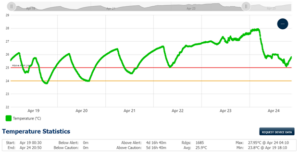Continuing with the desire for accurate temperature measurement, the next step after calibration is selecting the correct probe for the application. In most cases the selection simple. When monitoring refrigeration, nominal temperatures of 2 to 8 °C (36 to 46 °F) warmers 38 to 55 °C (100 to 130 °F) or freezers -45 to -15 °C (-50 to 5 °F), the thermistor is utilized. A thermistor is a type of resistor whose resistance is dependent on temperature, more so than in standard resistors.

The technology for the thermistor has advanced since its invention in the 1830’s. With vastly improved formulas and techniques over the past 20 years, the thermistors can now achieve precision accuracies over wide temperature ranges such as ±0.1 °C (±0.2 °F ) from 0 °C to 70 °C (30 to 155 °F) with excellent long-term stability. The accuracy in the lower temperatures, i.e. 0 to -45 °C (32 to -49 °F) are though less accurate, ±0.5 °C (±0.9 °F ); this is within the accuracy needed for monitoring frozen goods.
Tissue storage temperatures range from -80 °C (-112 °F ) Ultra Low to cryogenic storage, typically employing the physics of Liquid Nitrogen, LN2. These temperatures range from -160 °C (-256 °F) LN2 Vapor and LN2 Liquid -197 °C (-323 °F). Sensing these temperatures require specialized hardware. Two types of devices are common practice when monitoring temperatures in this range; they are the thermocouple and RTD (Resistor Temperature Detector). A thermocouple is an electrical device consisting of two dissimilar electrical conductors forming electrical junctions at differing temperatures. A thermocouple produces a temperature-dependent voltage as a result of the thermoelectric effect, and this voltage can be interpreted to measure temperature. Invented in 1821, the technology has not changed. Of the advantages of the thermocouple is the low cost. Additionally, its wide temperature range allows for application across a broad spectrum of uses. When compared to the thermistor, the accuracy of this device may be as much as 50 times less accurate. Its long term stability is considered to be variable, thus the need for regular calibration.

The RTD consists of a length of fine coiled wire wrapped around a ceramic or glass core. The element is usually quite fragile, so it is often placed inside a sheathed probe to protect it. The RTD element is made from a pure material whose resistance at various temperatures has been documented. The material has a predictable change in resistance as the temperature changes; it is this predictable change that is used to determine temperature. The RTD’s temperature range is -200 to 300 °C (-328 to 570 °F) with accuracy and long-term stability are similar to that of the thermistor.
The attributes of both the RTD and thermistor allow each to be exchanged with a like device. That is, a newly calibrated, NIST traceable thermistor may be excambed with confidence the accuracy will be maintained for a previously installed thermistor. Likewise for the RTD.



